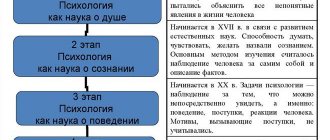Hi all! What stages of conflict development exist, what is their sequence and how to get out of them? You will learn about this and many other interesting things from this article.
Every person encounters conflict situations with loved ones, relatives or work colleagues. This often happens due to a lack of understanding of the logic of disagreement. There are even scientists who study these situations - conflictologists. They identified 3 main stages of the conflict.
Conflict implies versatility and mobility underneath. Quarrels are different, so there is no one exact concept. Thanks to the knowledge from this article, you will be able to get out of any conflict situation, you will understand all the stages of conflict resolution.
Stages of conflict situations
Psychology in the development of conflicts identifies several stages with distinctive features. Familiarity with the stages of conflict development that accompany the escalation of disagreements and their characteristics will help to find ways to solve the problem. The stages of conflict development are supported by the participants unconsciously, without deviating from the standard scenario. Emotional manifestations and the outcome depend on the preparedness of the parties.
Latent stage
When there are prerequisites for the emergence of disagreements, they speak of the emergence of a conflict. There are factors whose presence provokes disputes. These include:
- Problems with the transfer of information when misunderstandings arise or facts are distorted;
- Environment. Constant pressure on a person with an authoritarian leadership style, lack of opportunity to express one’s own opinion, participation in work without enthusiasm, lack of motivation lead to various kinds of contradictions;
- Features of character, worldview. Conflict arises when people with different values and views on problems meet. Incorrect communication, rudeness, and disrespect for others also provoke the development of discontent.
These reasons are not a reason for the development of a conflict, but represent the ground on which a dispute can easily flare up if the factors are not eliminated. Then the warring parties move on to the next stages of the conflict, from which it is more difficult to get out. Pre-conflict in its development includes the stages of emergence and awareness of the problem, attempts to resolve it peacefully and the emergence of a pre-conflict situation.
Conflict
When two parties come into interaction wanting to prove they are right or express an opinion, the next main stage of the conflict begins, tension. It is communication that infringes on the interests of the participants that characterizes the stage.
Disagreements become obvious to everyone, including those around you. Active expression of emotions is the main sign of the stage. How the conflict will develop depends on the preparedness of the parties. Usually emotions come first, so logic and sanity recede into the background. One of the parties is trying to limit the actions of the other, to deprive it of an object that is an element of the structure of the conflict. Insults are used, designed to humiliate, offend, and provoke emotions. Violence, the purpose of which is to inflict physical pain, is not excluded.
The manifestation depends on the degree of tension of the opponents, their ability to maintain composure and look at things soberly.
Note! If the motive for the conflict is hidden behind other reasons, people do not understand the essence of what is happening. As a result, discussions will be protracted. It is important to be aware of the problem in order to sort out the positions of opponents and begin to resolve disagreements.
Tense stage of the conflict
Solution of a problem
The parties understand that they need to look for the right solutions to get out of the situation. Actions are aimed at ending the conflict. The literature describes the following stages of conflict resolution:
- Cooperation;
- Compromise;
- Violence;
- Confrontation;
- Avoiding conflict.
The use of these templates allows you to achieve different results when both parties or one of them benefit. In this case, the other may be left with nothing or suffer great losses. The ability to conduct dialogue and understanding the essence of the problem will help you get out of the situation without going through all the stages of the conflict dynamics and suffer the least losses.
Post-conflict stage
The confrontation ends, the parties sum up the results, determine whether their expectations were justified. If the participants were able to come to an agreement and get out of the conflict with dignity, then, in addition to benefits, they receive the preservation of the relationship. A benevolent ending puts people in a positive mood, and the post-conflict is perceived as a way to reach a compromise. When one side loses, the disagreement leaves an unpleasant aftertaste and the relationship is destroyed. This may be the emergence of a new conflict, since interaction and, accordingly, information exchange will be disrupted.
Important! If you distinguish the stages of a conflict and manage them based on common sense and not on emotions, its completion will be satisfactory for all participants. You need to be able to hear your opponent and competently argue your position.
Peaceful solution to the conflict
Stages of conflict development.
Do you want to make better decisions, find your ideal career, realize your maximum potential and receive instructions for individual development?
?
All this can be done using the Human Design
. Build your map and get basic decryptions for free.
Stage 1. The emergence of a conflict or “nothing foreshadowed trouble.”
To recognize a conflict at the initial stage, you need super-intuition or many years of experience as a conflict specialist. At the very start, you can resolve the situation in simple ways. When time has not yet been spent on the conflict situation itself, opposition forces have not been formed, and outside participants have not been attracted. The best way to resolve the issue may be a simple conversation between employees, spouses, parents, and children. It will reduce destructive forces and lead to a constructive solution to the brewing confrontation.
For example: the arrival of a creative and freedom-loving employee at a company with strict disciplinary frameworks generates active resistance on his part. If you ignore resistance in the early stages, spend energy on training a newcomer, convincing, overcoming resistance, you can destroy the existing team, lose discipline and let the situation get out of control.
Take a character test
Stage 2. Maturation or “search for allies.”
At this stage, opponents already clearly define the scope of the controversial situation: work, friendship, family, relationships, power, money, sex, and so on. At the same time, preliminary work is being carried out to collect information and identify allies. Active negotiations are underway to find people who sympathize or do not sympathize with the opponent. Gradually, the formed groups concentrate and gain energy. Small skirmishes may occur at the same time, but a global clash has not yet reached. The best way to resolve the matter is through the intervention of an authoritative party who will help the parties meet and reach an agreement.
For example: low-intensity quarrels between different departments in an enterprise sometimes last for years. During this time, employees are more concerned with mutual accusations and discussing each other's shortcomings than with work. It is in the interests of the manager to gather opponents in one office, let them speak out, discuss and go their separate ways before disagreements lead to mass dismissal or open sabotage.
Stage 3. Incident or “trigger pulled.”
Unfortunately, sometimes participants only begin to recognize the conflict at this stage. When the roles of “victim”, “executioner”, “judge”, “bazaar woman”, “peacemaker”, “scapegoat” and others are already clearly distributed. No matter how carefully the opposition behaves, an unwashed cup, an incorrect number after the decimal point in a report, or any remark will become a click. As a result, a small pebble will lead to a rock collapse. The best thing to do at this stage is to concentrate on the reason for the disagreement, and not on the “small pebble”.
For example: a wife is dissatisfied with her husband’s earnings, her husband constantly criticizes her manner of housekeeping. But the cause of the scandal is a bad grade in the child’s diary. The child becomes not only a “pebble”, but also a “scapegoat”. Spouses should understand the reason for the discontent in time, not take it out on the children, but talk about everything in private.
Stage 4. Conflict or clash.
It is at this stage that aggression, rudeness, anger manifest themselves - all those signs of conflict, thanks to which many people gain negative experience and fear of conflict. But during a collision, information is exchanged. In a team you can learn about shortcomings in work or work organization, in a family you can reveal the reasons for dissatisfaction that have been hushed up for months. The best thing to do in this situation is to remember that peace is considered the best outcome of a quarrel.
For example: in the relationship between parents and teenagers there is rarely complete agreement. If you simply push with authority or pretend that nothing is happening, you can destroy the relationship forever. Therefore, it is worth trying to hear each other, choose words, and share your fears or experiences.
Stage 5. Development of the conflict or choice of tactics.
At this stage, the subject of the dispute remains unchanged, but the behavior of the opponents changes. Roles may even be redistributed. And now the attacker himself becomes the object of criticism. When the peak of tension and aggression subsides, opponents try to end the quarrel simply because the situation is unpleasant for them. The best thing you can do is to use logic, prudence, politeness, tact and sort things out to the end.
For example: overt rudeness, the phrases “you are a rude person” or “you are a deceiver” will transfer the conflict to the level of a showdown, and the original reason will remain behind the scenes. Therefore, you should not succumb to your opponent’s provocation and try to get to the bottom of the truth.
Conflict Prevention
Stages of relationships between a man and a woman - description of the main periods
To prevent conflict from developing, you need to remain calm. Emotions arise when reality does not meet expectations. You need to understand that people are not perfect, events do not always develop according to the planned pattern. It is important to control yourself, relying on reasonable arguments, and soberly assessing what is happening.
You need to try to take the side of the opposite side, look for common ground in order to identify a common goal. Working in one direction brings people together and makes confrontation pointless. It is important to treat your interlocutor with respect and not to get personal. Insults are unacceptable, especially if a person specifically seeks this, tries to bring the situation to a conflict. You always need to listen to the opposing opinion, evaluate its significance for yourself and your interlocutor, and voice your arguments. Conducting a discussion based on respect will help to come to a decision before emotional tension arises, then the tense stages of the conflict will bypass the discussion between the parties.
The ability to prevent conflicts before disputes escalate is an important skill. Already at school they begin to present information to children in the form of short courses of lectures. Students in grades 6-7 are introduced to the concept of interpersonal and group conflicts.
Conflict resolution
At what stage it is easiest to resolve a conflict depends on the participants and the goals they are pursuing. When interlocutors are ready to cooperate before violent disagreements begin, the problem can be resolved quickly and with maximum benefit. If there is a misunderstanding or lack of information, you need to bring the possible enemy to dialogue. Constructive communication will help you name the problem and resolve it peacefully. To do this, you need to understand the essence, find out the hidden motive of the conflict, if there is one.
Types of human memory in psychology, classification of main types
The interlocutor's disposition is a mandatory attribute to determine the cause of disagreements.
Additional Information. Communication on a friendly wave without going into personal topics, using appropriate jokes will help create a comfortable atmosphere for conversation. When a participant's goal is to achieve a certain result, and he does not intend to retreat, it will not be possible to resolve the problem peacefully. Behavior will be characterized by aggressiveness. You need to assess possible losses and decide on tactics, retreat before the fight begins, or try to reach a compromise.
Aggression in conflict
You cannot avoid conflict, hoping for its independent resolution. Such tactics of behavior will postpone the acute stage of the process, but will not eliminate the cause. Understanding the problem and the desire to listen to your interlocutor will help you quickly cope with the situation.
The most effective method of resolving disagreements is cooperation. When parties come together to achieve a common goal, this is achieved with mutual understanding between the participants, achieved as a result of negotiations. A compromise will solve the problem with minimal losses or benefits for both parties. Participants, based on the information received and their own opinions, make a decision that suits everyone.
Confrontation and violence are used when one of the participants is superior. He may have unlimited power or resources. It is not possible to resist him, since he is not interested in arguments and another point of view. The goal is to get what you want in any way. Such tactics should be used as a last resort, if the result is too important and there is no other option but to force the opponent to comply with inconvenient demands.
Object of conflict
Every conflict has its own reasons and arises due to the need to satisfy some needs. A value that can satisfy such a need and because of whose ownership conflicts arise is its object. The object of the conflict can be material, spiritual and social values. For example, the simplest type of interpersonal conflict is a quarrel between children over a toy in kindergarten. In this case, the object of the conflict is the toy as a material value.
Are you an expert in this subject area? We invite you to become the author of the Directory Working Conditions
Causes of conflicts
Adolescence crisis in psychology - what is it, reasons
Conflict situations are provoked by various factors, which are divided into groups:
- Personal. They depend on a person’s reaction to changes happening around him, his ability to communicate, and conduct a dialogue. Usually conflict is provoked by emotionally unstable people who are not prepared to work in a team. When they don’t know how to resolve disagreements peacefully, they can’t win them over, and it’s impossible for them to reflect the emotions of their interlocutor;
- Social. Associated with behavioral characteristics, established standards, accepted norms. Disagreements arise when there is a conflict between people belonging to different generations, the incompatibility of interlocutors in character, temperament, and adherence to different values. Having a leader who creates his own agenda that conflicts with the overall goals of the organization can lead to negative consequences. Discord in the team occurs even when a new employee appears, if his adaptation is delayed;
- Objective. They arise when people’s values and interests collide. Problems can be real or fictitious, existing only in the imagination. That is, a person assumes the presence of a difficulty, gets himself worked up out of nowhere, which happens in the absence of communication and lack of information;
- Organizational. Occur in the course of professional activity. Associated with the employee’s inadequacy for the position held, when he is unable to cope with the responsibilities. An example is situations provoked by managers if they incorrectly distribute work among subordinates, cannot establish relationships between them, and incorrectly formulate tasks.
The factors provoking conflicts are not limited to the listed reasons. Knowing the motive is the first step towards getting out of it. It is important to determine the type of conflicts, whether they are objective or subjective, in order to understand the tactics of behavior and not lead to the emotional development of the intense phase of the conflict.
favorable ending to a conflict situation
Conflict situations are inevitable both in life and in a professional environment. There is no need to avoid or evade them; it is important to establish communication and know the sequence of stages of the conflict and ways to get out of them with minimal losses.
Conflictology tests with answers for teachers and students
Correct answers are marked +
1. A pre-conflict situation is:
+ increasing social tension between opponents - potential participants in the conflict due to the contradictions that have arisen;
- using a threat as a way to influence an opponent during negotiations;
- an action that is directed against someone else.
2.Test. Stimulating conflict involves:
+ purposeful actions of the subject of management aimed at the emergence of a constructive conflict;
— deliberate disruption of the work process in the form of refusal or improper performance of one’s duties;
- persistent struggle for one’s interests that conflict with others.
3. Conflict prevention is:
+ actions of the manager to prevent and neutralize conflict factors;
— punishment of opposing opponents for participating in the conflict;
— peaceful settlement of conflicts that have arisen before the outbreak of open conflict.
4. The stages of the conflict include:
+ pre-conflict situation; open conflict with incident, escalation and termination; post-conflict period;
— the emergence of contradictions, the stage of attempts to reduce tension, the growth of contradictions, conflict resolution;
— incident, escalation, reconciliation.
Test - 5. Compromise is impossible in conflict:
+ values;
— interests;
— resources.
6. The subject of conflictology is:
+ patterns of emergence and development of conflict contradictions, dynamics and directions of development of conflict situations, methods and methods of prevention, resolution and management of conflicts;
— causes of conflicts in different social spheres and ways to resolve them;
— prerequisites for the emergence of contradictions in various social strata of society, their prevention and resolution peacefully.
7. Conflictology as a science arose, emerging from the sciences:
+ sociology and psychology;
— philosophy and political science;
— pedagogy and cultural studies.
8. An incident in conflict management is:
+ a formal reason allowing the parties to the conflict to begin open opposition;
- the true reason for the emergence of irreconcilable contradictions;
- a negative perception of someone's superiority or success.
9. The object of conflictology is:
+ social conflict as a specific type of social interaction between subjects;
— interpersonal conflicts of colleagues in the process of work;
— political contradictions at different levels of government, including international conflicts.
10. The founder of American conflictology is considered to be:
+ L. Koser;
— K. Boulding;
— E. Bern.
11.Test. The first stage of the development of conflictology is characterized by:
+ formation and development of knowledge about the nature, principles and types of conflicts;
— the emergence of conflict theories and particular concepts;
— the study of conflict as an independent phenomenon.
12. Raising the level of mutual awareness of the parties is a function of conflict:
+ informational;
— preventive;
- signal.
13. What is tolerance?
+ Absence or rather insignificant reaction of the parties to the conflict factor;
— Increased discontent, negative psychological tension and destructive social connections;
— Unfair use of public information.
14. What is authority?
+ Recognition by other people of the influence and significance of someone;
- A subject who is distinguished by particularly active actions;
- A person for whom the interests of others are higher than his own.
15. Breaking a relationship as a sign of protest against the opponent’s behavior is called:
+ boycott;
- bluff;
- rebellion.
16. Public expression of opinions and discussion of key points is:
+ debate;
- conversation;
- declaration.
17. Freezing the conflict involves:
+ its postponement while maintaining existing contradictions;
— studying the contradictions that have arisen to determine their causes and forecast;
— prohibition of the managing entity from participating in the conflict in the name of common interests.
18. What strategy of conflict behavior consists of refusing to participate in the conflict while maintaining existing contradictions?
- Avoidance;
— Denunciation;
- Mediation.
19. Contradictions between subjects of equal status are a conflict:
+ Horizontal;
— Intergroup;
— Political.
20. A crisis in conflict management is:
+ the point of increasing severity of the conflict, upon reaching which the situation changes radically towards retreat or the use of force;
- state of emotional release;
— inadequate emotional reaction to a conflict-generating factor.
21. A person who has not adapted to social values and conditions, even to the point of completely denying them, is called:
+ marginal;
- a heretic;
- a mediator.
22. Retaliatory behavior adequate to the harm caused is:
+ revenge;
- violence;
— mobbing.
23. Negotiations as a method of conflict resolution are:
+ putting forward their demands to each of the parties with a simultaneous readiness to compromise;
- seeking help from a third party;
— obligations given by the parties to the conflict to restore peaceful relations.
24. The use of various methods of pressure, including threats, in the process of negotiations is:
+ pressing;
- revenge;
- manipulation.
25. A renegade is a person who:
+ after a conflict arose with his group, he left it and began to fight from the outside;
- has an inflated level of claims;
- acts as a mediator in resolving a conflict situation.
26. A relatively stable and simplified image of a social object is called:
+ stereotype;
— parity;
- layout.
27. An ultimatum is:
+ a categorical demand from one side of the conflict to the other with the threat of using radical measures to resolve the dispute if this demand is not met;
- a form of violence, which is characterized by special cruelty and intimidation in the name of achieving one’s goals;
— readiness to perceive future events as objectively as possible.









